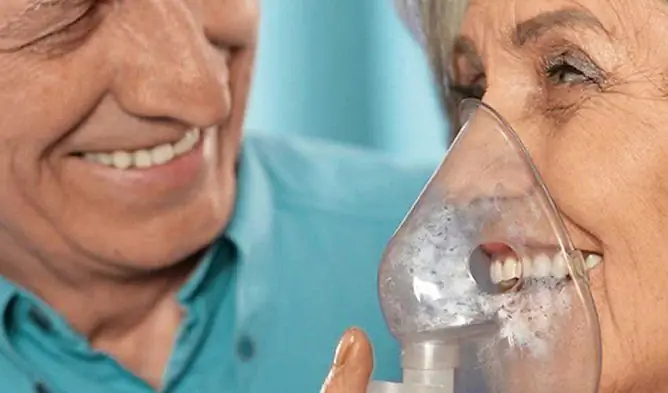- Author Rachel Wainwright [email protected].
- Public 2023-12-15 07:39.
- Last modified 2025-11-02 20:14.
Atrovent N
Latin name: Atrovent N
ATX code: R03BB01
Active ingredient: ipratropium bromide (ipratropium bromide)
Manufacturer: Boehringer Ingelheim Pharma (Germany)
Description and photo updated: 2018-29-11
Prices in pharmacies: from 225 rubles.
Buy

Atrovent N is a bronchodilator.
Release form and composition
Dosage form - metered dose inhalation aerosol: clear, colorless liquid that does not contain suspended particles [10 ml (200 doses) each in stainless steel cans equipped with a mouthpiece and a dispensing valve; in a cardboard box 1 can and instructions for use of Atrovent N].
Composition of 1 inhalation dose of aerosol:
- active substance: ipratropium bromide monohydrate - 21 μg, which corresponds to 20 μg of anhydrous ipratropium bromide;
- auxiliary components: purified water, citric acid, absolute ethanol, tetrafluoroethane (HFA 134a, propellant).
Pharmacological properties
Pharmacodynamics
The active substance of Atrovent N is ipratropium bromide - a blocker of m-cholinergic receptors, a bronchodilator. The substance has the ability to block m-cholinergic receptors of smooth muscles of the tracheobronchial tree and suppress reflex bronchoconstriction.
Ipratropium bromide is structurally similar to the acetylcholine molecule and is a competitive antagonist. Due to its anticholinergic properties, the drug prevents an increase in the intracellular concentration of calcium ions, which occurs due to the interaction of acetylcholine with m-cholinergic receptors located in the smooth muscles of the bronchi. The release of calcium ions occurs with the participation of secondary mediators (mediators), including with the help of diacylglycerol (DAG) and inositol triphosphate (ITP).
Atrovent N effectively prevents bronchoconstriction when exposed to negative factors, such as inhalation of cold air or cigarette smoke, the action of various bronchoconstrictors. Also eliminates spasm caused by the influence of the vagus nerve.
Due to inhalation use, the drug has almost no resorptive effect (the development of tachycardia is possible only after inhalation of about 500 doses). The bronchodilation that occurs after inhalation is mainly a consequence of the local and specific effect of ipratropium bromide on the lungs, and not the result of its systemic effect. The drug has no negative effect on gas exchange, mucus secretion in the respiratory tract and mucociliary clearance.
In controlled studies carried out for 85-90 days in patients with bronchospasm caused by emphysema, chronic bronchitis and chronic obstructive pulmonary disease (COPD), a significant functional improvement of the lungs was noted within 15 minutes after inhalation, the maximum reached after 1-2 hours, lasted up to 4-6 h.
In bronchial asthma, a significant improvement in the function of external respiration is noted in 51% of patients.
Pharmacokinetics
The therapeutic effect of ipratropium bromide occurs due to its local action in the respiratory tract, therefore, the development of bronchodilation is not parallel to the pharmacokinetic parameters.
When Atrovent N is used by inhalation, only 10-30% of the dose enters the lungs, the rest settles in the mouth or pharynx, is swallowed and enters the gastrointestinal tract. The amount of the drug entering the lungs reaches the systemic circulation within a few minutes.
The total systemic bioavailability of ipratropium bromide for oral administration and inhalation is 2% and 7-28%, respectively.
No more than 20% binds to plasma proteins.
The kinetic parameters characterizing the distribution of ipratropium bromide were calculated on the basis of its plasma concentrations after intravenous (i.v.) administration: a rapid two-phase decrease in plasma concentration was noted, the apparent volume of distribution in an equilibrium state is approximately 2.4 L / kg (on average 176 L).
The substance does not penetrate the placental and blood-brain barriers.
After intravenous administration of ipratropium bromide, about 60% of the dose is metabolized by oxidation (mainly in the liver). By dehydration, hydrolysis or separation of the hydroxymethyl group from tropic acid, metabolites are formed that could be identified. They are considered inactive, weakly bind to muscarinic receptors, and are excreted in the urine.
The total clearance of ipratropium bromide is 2.3 ml / min, renal clearance is 0.9 l / min. The half-life (T ½) in the terminal phase is approximately 1.6 hours.
The total renal excretion (within 6 days) of a dose labeled with an isotope (ipratropium bromide and all its metabolites) was: with intravenous administration - 72.1%, with oral administration - 9.3%, with inhalation use - 3, 2%.
The total excretion through the intestine of the isotope-labeled dose was: with intravenous administration of ipratropium bromide - 6.3%, with ingestion - 88.5%, with inhalation use - 69.4%.
Thus, after intravenous administration of an isotope-labeled dose, the drug is excreted mainly through the kidneys. T ½ of the starting substance and its metabolites is 3.6 hours.
Indications for use
- COPD, including chronic obstructive bronchitis and pulmonary emphysema;
- bronchial asthma of mild to moderate severity, especially in patients with concomitant cardiovascular diseases.
Contraindications
Absolute:
- I trimester of pregnancy;
- children under 6 years old;
- increased sensitivity to atropine or its derivatives;
- known hypersensitivity to any component of Atrovent N.
With extreme caution, only as directed by a doctor and under his supervision, the drug can be used in the following cases:
- cystic fibrosis;
- obstruction of the urinary tract (for example, with obstruction of the bladder neck or prostatic hyperplasia);
- angle-closure glaucoma;
- II - III trimesters of pregnancy;
- children over 6 years of age.
Atrovent N, instructions for use: method and dosage
Atrovent N is used by inhalation.
The doctor selects the optimal doses individually. Unless otherwise prescribed, adults and children over 6 years of age are usually given 2 doses (injections) 4 times a day. In total, it is not recommended to use more than 12 doses during the day, since the need for a larger amount of the drug, as a rule, indicates the need for additional prescription of other methods of treatment.
During the use of the drug, the patient should be under medical supervision. It is forbidden to independently increase the prescribed dose both during maintenance treatment and during the period of emergency therapy.
If, against the background of the use of Atrovent N, there is no significant improvement, or the condition worsens, a doctor's consultation is required. It is also necessary to urgently consult a medical specialist in case of rapid or unexpected increase in shortness of breath (difficulty breathing).
Before using each new inhaler for the first time, take it upside down, remove the protective cap and press the bottom of the cartridge twice to make two injections into the air - this is necessary for the correct dosing of the drug. If the inhaler is not used for more than 3 days, one injection into the air is sufficient.
The process of using the inhaler:
- Remove the protective cap.
- Holding the inhaler upside down (the arrow also points up), tightly wrap your lips around the mouthpiece.
- Take a deep breath.
- Starting to take a deep breath, press firmly on the bottom of the can to inhale one dose. Continue to inhale slowly to the maximum, then hold your breath for a few seconds.
- Remove the mouthpiece from your mouth and exhale slowly.
- If it is necessary to administer several doses, repeat steps 2-5.
- Put a protective cap on the inhaler.
The can is opaque, so it is impossible to visually determine the moment when it becomes empty. It contains 200 doses. After using them, it may seem that the balloon still contains some amount of liquid, however, it is recommended to replace the balloon with a new one, otherwise there is a risk of not receiving the required therapeutic dose.
You can check the amount of the drug in one of the following ways:
- Shake the container - this way you can understand if there is any liquid left in it.
- Having removed the mouthpiece from the can, put it in a container with water. The approximate amount of the drug in the cylinder can be estimated by its position in the water: if the cylinder sinks, it contains at least ¾ of the aerosol; if it plunged into the water upside down exactly vertically - ½, plunged into the water upside down and tilted slightly to the side - ¼, plunged into the water upside down and lay down on its side - the balloon is empty.
At least once a week, the inhaler should be cleaned from dust / dirt and aerosol residues - they can prevent the full release of a new dose.
Inhaler cleaning rules:
- Remove the protective cap and remove the cylinder.
- Pass a stream of warm water through the inhaler, make sure there is no visible dirt and drug residues.
- Shake the inhaler and leave it to air dry (do not use heating devices).
- Insert the bottle and put on the protective cap.
The plastic mouthpiece is used for accurate dosing of the drug and is specially designed for use with Atrovent N. aerosol. It is prohibited to use it for dosing other aerosols. Also, do not use other mouthpieces with Atrovent N.
Side effects
- from the respiratory system: often (from ≥ 1/100 to <1/10) - irritation of the pharyngeal mucosa, cough; infrequently (from ≥ 1/1000 to <1/100) - dryness of the pharynx, laryngospasm, pharyngeal edema, bronchospasm (including paradoxical);
- from the digestive system: often - dry mouth, impaired motility of the gastrointestinal tract, nausea; infrequently - swelling of the oral mucosa, stomatitis, constipation, diarrhea, vomiting;
- from the nervous system: often - headache, dizziness;
- from the immune system: infrequently - hypersensitivity reactions, angioedema, anaphylactic reactions; rarely - urticaria;
- from the urinary system: infrequently - urinary retention;
- from the cardiovascular system: infrequently - palpitations, supraventricular tachycardia; rarely - increased heart rate, atrial fibrillation;
- on the part of the organ of vision: infrequently - pain in the eyes, conjunctival hyperemia, mydriasis, blurred vision, corneal edema, the appearance of a halo around objects, increased intraocular pressure, glaucoma; rarely - violation of accommodation;
- on the part of the skin and subcutaneous tissues: infrequently - skin rashes, itching.
Overdose
There are no specific symptoms of ipratropium bromide overdose. Signs of systemic anticholinergic action may develop, such as dry mouth, increased heart rate, and visual impairment. Given the local route of administration and the spectrum of therapeutic action of Atrovent N, the occurrence of any serious anticholinergic manifestations is unlikely.
Overdose treatment is symptomatic.
special instructions
In rare cases, after inhalation, immediate-type hypersensitivity reactions occur, their signs may be rash, urticaria, oropharyngeal edema, angioedema, bronchospasm, anaphylaxis.
Like any inhalation agent, Atrovent N can cause a potentially life-threatening paradoxical bronchospasm. In this case, the drug is immediately canceled and alternative therapy is prescribed.
Special care should be taken when inhaling the drug in order to avoid contact with the eyes. The aerosol is released only when the balloon is firmly pressed and enters the oral cavity from the mouthpiece, so the likelihood of its contact with the eyes is low.
If inhaled ipratropium bromide gets into the eyes, complications from the organ of vision, such as mydriasis, pain in the eyes, an increase in intraocular pressure, and the development of angle-closure glaucoma may occur.
With observance of precautions, Atrovent N should be used in patients with a predisposition to angle-closure glaucoma.
Acute angle-closure glaucoma may present with the following symptoms: discomfort or pain in the eyes, the appearance of colored spots before the eyes or a halo on objects, blurred vision in combination with corneal edema and redness of the eyes due to injection of the conjunctival vessels. If any combination of the described phenomena occurs, it is necessary to use eye drops that reduce intraocular pressure, and urgently consult a doctor.
It is necessary to take into account a small amount of ethanol in the composition of Atrovent N: in 1 dose - 8.415 mg.
If, against the background of therapy, the effect is not pronounced enough, or the condition worsens, a doctor's consultation is required, who will adjust the treatment regimen. Immediate medical attention is also needed in case of sudden onset and rapid progression of shortness of breath.
Influence on the ability to drive vehicles and complex mechanisms
Special studies on the effect of ipratropium bromide on the cognitive and psychomotor functions of the patient have not been conducted. Given the likelihood of tremor, dizziness and mydriasis, visual impairment and eye accommodation, caution should be exercised during drug treatment. In the event of the development of these phenomena, it is recommended to refrain from performing potentially hazardous activities, including driving a car and working with complex mechanisms.
Application during pregnancy and lactation
In the course of preclinical studies, neither embryotoxic nor teratogenic effects of the drug were detected when inhaled at doses significantly higher than those recommended for humans. However, the safety of ipratropium bromide during pregnancy in humans has not been established. In this regard, Atrovent N is contraindicated in the first trimester, in the II-III trimesters, it can be used only in cases where the benefits to the woman are definitely higher than the potential risks to the fetus.
Whether ipratropium bromide is excreted in breast milk is unknown. However, given the inhalation route of its administration, the intake of significant amounts of the drug is unlikely. Nevertheless, the use of Atrovent N during lactation should be carried out with precautions.
Clinical studies on the effect of ipratropium bromide on fertility have not been conducted. According to preclinical data, there is no negative effect on fertility.
Pediatric use
Aerosol for inhalation Atrovent N is contraindicated in children under 6 years of age; at an older age, it should be used only as directed by a doctor, as well as under the close supervision of adults to avoid taking an excessive dose or improper use of the inhaler.
With impaired renal function
Atrovent N should be used with caution in patients with urinary tract obstruction.
Drug interactions
The simultaneous long-term use of other anticholinergic drugs is not recommended, since the possible effects of such combinations have not been studied.
The bronchodilator effect of Atrovent N can be enhanced by xanthine derivatives and beta-adrenergic drugs.
The anticholinergic effect of the drug is enhanced by tricyclic antidepressants, quinidine and antiparkinsonian drugs.
Analogs
Analogs of Atrovent N are: Atrovent, Inkruz Ellipta, Bretaris Jenueir, Ipratropium-Aeronativ, Ipratropium-Nativ, Ipratropium Steri-Neb, Ipraterol-Aeronativ, Spiriva, Spiriva Respimat, Sibri Breezhaler, Truventyvra and Tiotropia dr.
Terms and conditions of storage
Keep out of the reach of children at a temperature not exceeding 25 ° C. Do not open the can and do not expose it to heat over 50 ° C (aerosol is under pressure).
The shelf life is 3 years.
Terms of dispensing from pharmacies
Dispensed by prescription.
Reviews about Atrovent N
Patients leave positive reviews about Atrovent N, noting its high bronchodilatory effectiveness, relatively low cost, and also a convenient inhaler.
Price for Atrovent N in pharmacies
The approximate price for Atrovent N for 1 bottle of 10 ml (200 aerosol doses) is 325-417 rubles.
Atrovent N: prices in online pharmacies
|
Drug name Price Pharmacy |
|
Atrovent N 20 μg / dose 200 doses aerosol for inhalation, dosed 10 ml 1 pc. 225 RUB Buy |
|
Atrovent N aerosol for in. dosage. 20mkg / dose 200 doses 10ml 327 r Buy |

Anna Kozlova Medical journalist About the author
Education: Rostov State Medical University, specialty "General Medicine".
Information about the drug is generalized, provided for informational purposes only and does not replace the official instructions. Self-medication is hazardous to health!






